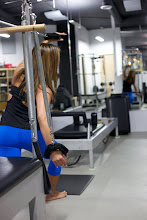
there is a reason why injured or recovering people incorporate pilates in their rehabilitative and exercise programs. not only does the method reinforce fundamental core stability with every exercise, it also conditions the complex network of muscles in the joints with controlled, precise and low-impact movements.
an unstable core will put more pressure on the muscles of the appendages (the arms and legs) to work more than they have to. so many injuries and ailments are actually caused by instability and imbalance in these key areas.
for example, painful shoulder impingement (or even an aching neck!) might be caused by an over-contraction of muscles that elevate the shoulders towards the ears and rotate them in towards the chest. deliberate and low-impact exercises like “side arm push downs”, "long back stretch", “pulling straps” and “T” encourage proper alignment in joint mobility by strengthening muscles that rotate the shoulders outward and depress them securely toward the ribcage.
rehabilitation and muscle conditioning with pilates guarantees unnecessary stress on the body that is often found in high-impact, ballistic or heavy weight-bearing exercise. even the most advanced and challenging moves shift the body position in the most subtle ways! many of the controlled, low-impact movements could be deceivingly subtle. this is because the work is very deep and precise, calling for the student to keenly prioritize core integration with safe ranges of motion and balance of movement.

No comments:
Post a Comment